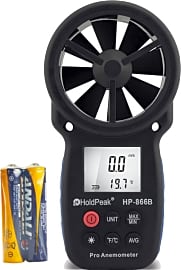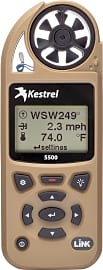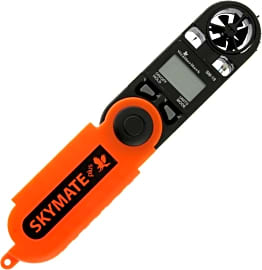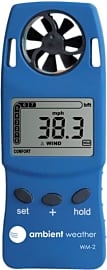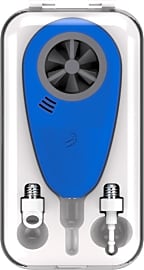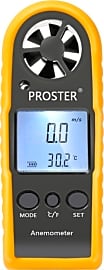The 10 Best Wind Meters

This wiki has been updated 38 times since it was first published in October of 2015. Wind speed is an important factor in weather forecasting, aircraft and maritime operations, construction projects, ballistic crime analysis, and the growth rate of various plant species. These meters will give you remarkably accurate readings, and many come with a handful of additional helpful features, like protective cases and lanyards. Here, you'll find stationary as well as handheld options. When users buy our independently chosen editorial choices, we may earn commissions to help fund the Wiki.
Editor's Notes
November 24, 2020:
Although static, fixed-wind indicators are useful for the home for many reasons, the handheld models are more adaptable and are considered as important safety items for fans of watersports. When weather, humidity, and wind speed could be the difference between life and death, these instruments are vital. To this end, the WeatherHawk SM-19 was added to the list for its upgraded features compared to the previous model, which does not have a windchill display or a hygrometer for relative humidity and dew point information.
April 21, 2019:
In compiling this collection of wind meters, the features that were prioritized include the sensor's range of wind speed sensitivity, easily navigable menus, and overall dependability and durability. Other appealing details that influenced our decision-making process were Bluetooth connectivity, ergonomic design, and extras like rubberized protective cases that mitigate damage when accidents inevitably occur.
The Caldwell Crosswind Professional and WindMate 350 were removed due to complaints about inaccuracy. To provide users a wider variety of choices, we’ve added the AcuRite Station and AcuRite 5-in-1, which boast additional weather detecting features. They may not be handheld, but they're a great solution for individuals who need to access wind speed data on a frequent basis.
Special Honors
Skywatch Geos Portable Expensive for a hand-held unit, this is, however, a complete weather gauge that will give you the wind speed, temperature, humidity, and altitude as well as barometric pressure. This is the choice for the true explorer, with remarkable accuracy as well as a hardy construction that is suitable for particularly harsh environments. kiteboarding.com
Choosing the Best Wind Meter
For those who require more comprehensive airspeed data, look for a device that can take longer readings and that can store information from multiple readings.
A wind meter is a valuable tool useful for collecting data that can be used to further science, education, and commercial development, as well as for recreational purposes. Most wind meters -- which are technically called "anemometers" -- feature a rotary blade set into a handheld case. They operate simply by being held aloft while facing into the prevailing wind. Any decent wind meter will be able to give you a reading of the speed of a gust or breeze, and if you only need the ability to calculate the present wind speed (which might affect the imminent launch of a kite or drone aircraft), even the simplest, lowest-cost unit will suffice.
For those who require more comprehensive airspeed data, look for a device that can take longer readings and that can store information from multiple readings. Some lower-cost options can log only a minute's worth of wind speed information, which may be insufficient to create any accurate modeling of the airflow patterns in a given area.
A different type of wind meter has seen greater popularity since its development a few years back: these connect directly to a smartphone or tablet, using the software on your device to calculate the data captured using external hardware. These options vary in form, with some utilizing the traditional spinning cup design first seen in the middle of the 1800s. While use of these options by definition necessitates ownership of (or at least access to) additional hardware, it also means much easier access to the data thereby collected. Many apps that partner with smartphone wind meters simplify and enrich the process of interpreting the information you collect.
Who Needs a Wind Meter, Anyway?
When it comes to a surprisingly large range of professions and hobbies, the answer truly is "blowing in the wind." For a meteorologist to make accurate predictions of imminent weather patterns, accurate readings of wind speeds are critical. Proper forecasting relies partially on an established knowledge of regular weather patterns based on location and season, but is largely predicated on collecting and analyzing immediate data. Recorded wind speeds are a crucial piece of that data set.
A change in wind speed or direction can have a dramatic effect on a plane or helicopter during takeoff and landing, and must be checked precisely.
Many architects and engineers also must invest a great deal of time and energy into calculating wind speeds, the potential power of gusts and steady breezes, and the frequency with which wind will blow in certain areas. Wind can have powerful and potentially devastating effects on tall buildings, bridges, power lines, and other types of construction, and the airflow of a given area must be fully understood before any construction project is ever commenced. So, too, must a designer and/or builder consider how they structure they plan to erect might alter or intensify the movement of air in proximity.
Those involved with aviation are also intimately familiar with air currents, as the direction, speed, and frequency of wind plays a huge role both in planning flights and in safely managing aircraft that are already aloft. A change in wind speed or direction can have a dramatic effect on a plane or helicopter during takeoff and landing, and must be checked precisely. While any established airport will have myriad monitoring devices in place at all times, a wind meter can help ensure a safe takeoff or landing of a helicopter used for a medical evacuation or for a smaller plane operated at a private (or simply less-developed) airstrip.
Boaters also have an intimate relationship with wind, especially those who rely on it as their primary source of propulsion. Safe sailing necessitates ready access to accurate information on wind speed, and no sailor should ever take to the water without a wind meter.
Finally, a wind meter is a great tool for many hobbyists to own. Whether you are involved in model rocketry, flying an RC airplane, or you use a drone/quadcopter, knowing how fast the wind is blowing can help you have a safer, better-controlled flight. And in fact, as some flying objects are only safe when operated in certain conditions, knowing wind speed might be critical for participation in your hobby.
A Few Words on Wind
Wind is an amazing thing, too often overlooked in the course of our daily lives. Thanks to the careful work of the people who design our cars to exhibit minimal wind resistance, we hardly notice a stiff crosswind as we drive. Thanks to the expertise of the architect who develops plans for a skyscraper, we never worry about a downtown disaster caused by a violent wind storm.
While our modern skills in engineering and design can help mitigate many of the effects air currents would otherwise have on our lives, one can still appreciate the awesome, raw power of this elemental force by learning just a few staggering statistics.
Wind is an amazing thing, too often overlooked in the course of our daily lives.
First, a few words on the terminology commonly associated with wind. Any air flow between zero and 27 knots (about 31 mph) is considered a breeze and can be further described as light, moderate, and strong. The next category of windspeed is called a gale and pertains to winds blowing between around 27 and 60 knots. These are broken down as moderate, strong, and whole gale-force winds. Once windspeed is above the 63 knot mark (or 72 mph) the wind has reached hurricane force.
Despite the fact that the tallest mountain in the continental United States, Mt. Whitney (which stands at just 14,500 feet in elevation) is in California's Sierra Nevada range, the fastest mountain windspeed ever recorded was on New Hampshire's much lower Mount Washington, elevation 6,288 feet. On April 12, 1934, a wind gust on Mount Washington was recorded at 231 mph. This is, in fact, the fastest ever recorded windspeed not caused by a tropical storm. Hurricane force winds have been recorded at 253 mph, while tornadoes have been known to reach speeds of just over 300 mph.
As far as an impressive daily average speed, in April of 1951, the remote Port Martin research outpost on Antarctica experienced a period of such ferocious storms that the average wind speed for the day was 108 mph.



